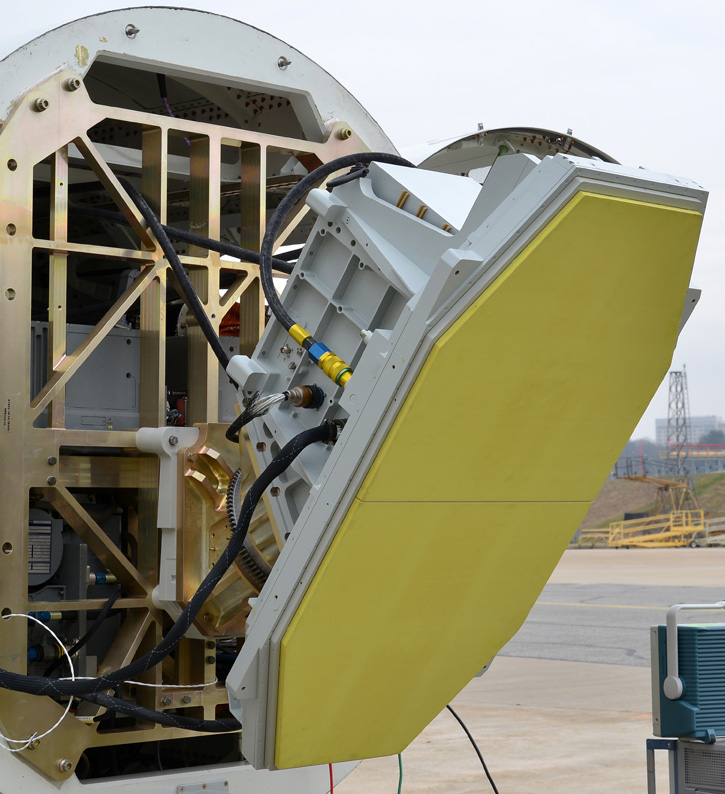
Northrop Grumman Corporation is introducing an improved radar for the U.S.Air Force B-1B Lancer bomber. The new radar called Scalable Agile Beam Radar – Global Strike (SABR-GS) was presented by Northrop Grumman at the Lancer’s 30th Anniversary Reunion held at Dyess Air Force Base, Texas. Developed as an affordable, low risk radar retrofit solution, SABR-GS offers advanced operational capabilities and greater system reliability, compared with legacy APQ-164 passive ESA currently used on the bomber.
The new radar provides large synthetic aperture radar maps, advanced image processing and sensor integration that provides a significant advantage in situational awareness for the crew, enabling the B-1 powerful new capabilities for intelligence, surveillance, reconnaissance and targeting.
Northrop Grumman’s SABR-GS is a full performance, multi-function, active electronically scanned array (AESA) radar for the B-1. As a derivative of the AN/APG-83 SABR, SABR-GS takes advantage of hardware, legacy modes and advanced operating modes proven on the F-35, F-22 and F-16 aircraft.
Nearly three times the size of the F-16 SABR system, SABR-GS offers unprecedented target area detail and digital maps under all weather conditions. Open architecture standards have been used to integrate data from other onboard sensors, enabling continued innovation and affordability for the life of the system.

“By developing SABR-GS, we’ve enabled capabilities now critical to the mission – a significant milestone for SABR technology and the B-1,” said Paul Kalafos, vice president, surveillance systems business unit, Northrop Grumman. “By leveraging the successes of the SABR for the F-16 fighter, we have activated cost savings for the U.S. Air Force’s B-1 program, proven that SABR AESA technology is scalable and extended the survivability of the aircraft for the next 25 years. The APG-83 version of SABR has been integrated into the F-16 and is part of the F-16A/B upgrade for Taiwan.
The development of SABR-GS took place under a $21 million risk reduction contract awarded in 2011 by the Air Force B-1 Systems Program Office. Northrop Grumman has demonstrated in flight, the advanced B-1 AESA and advanced sensor and fusion processing, readying the radar for the engineering, manufacturing and development phase.
The completion of this contract follows the successful Radar Modernization Improvement Program (RMIP), in which Northrop Grumman modernized the radar receivers and processors of the B-1. SABR-GS will replace the APQ-164 radar antenna currently deployed on all B-1 bombers.
The current upgrade implemented on the bomber is part of Sustainment Block 16 (SB-16) – the largest and most comprehensive in the Lancer’s life cycle so far. SB-16 includes upgraded navigation and radar systems, modernized cockpit that the replaced the two monochrome pilot and co-pilot displays with four color MFDs (Multi Function Display); a Fully Integrated Data Link and a Central Integrated Test System (used to detect and troubleshoot anomalies) in the aft station; introduction of modern moving map and user friendly symbology.
These modifications are part of the Integrated Battle Station (IBS) initiative, which will be fully implemented by 2019.
The B-1B is a modernized version of the B-1A Lancer supersonic strategic bomber of which only four were produced by the original manufacturer in the early 1970s. Serial production of the bomber began in 1986 with an order of 100 B-1B bombers, redesigned and revised into multi-mission bombers – a new variant of the original design, designed to evade enemy detection by flying at high subsonic speed at low level. To enable such flight it is using its APQ-164 multi-mode radar as a terrain following sensor. Built by Westinghouse (currently supported by Northrop Grumman), the APQ-164 radar employs passive electronically scanned array technology with electronic beam steering, enabling the fixed antenna to be pointed downward for reduced radar observability. Apart from terrain following, the radar also provided high resolution (10-foot to 160-foot resolutions) synthetic aperture radar (SAR) mapping and ground moving target indication (GMTI) for navigation and targeting of nuclear and strategic weapons in all weather conditions.





















